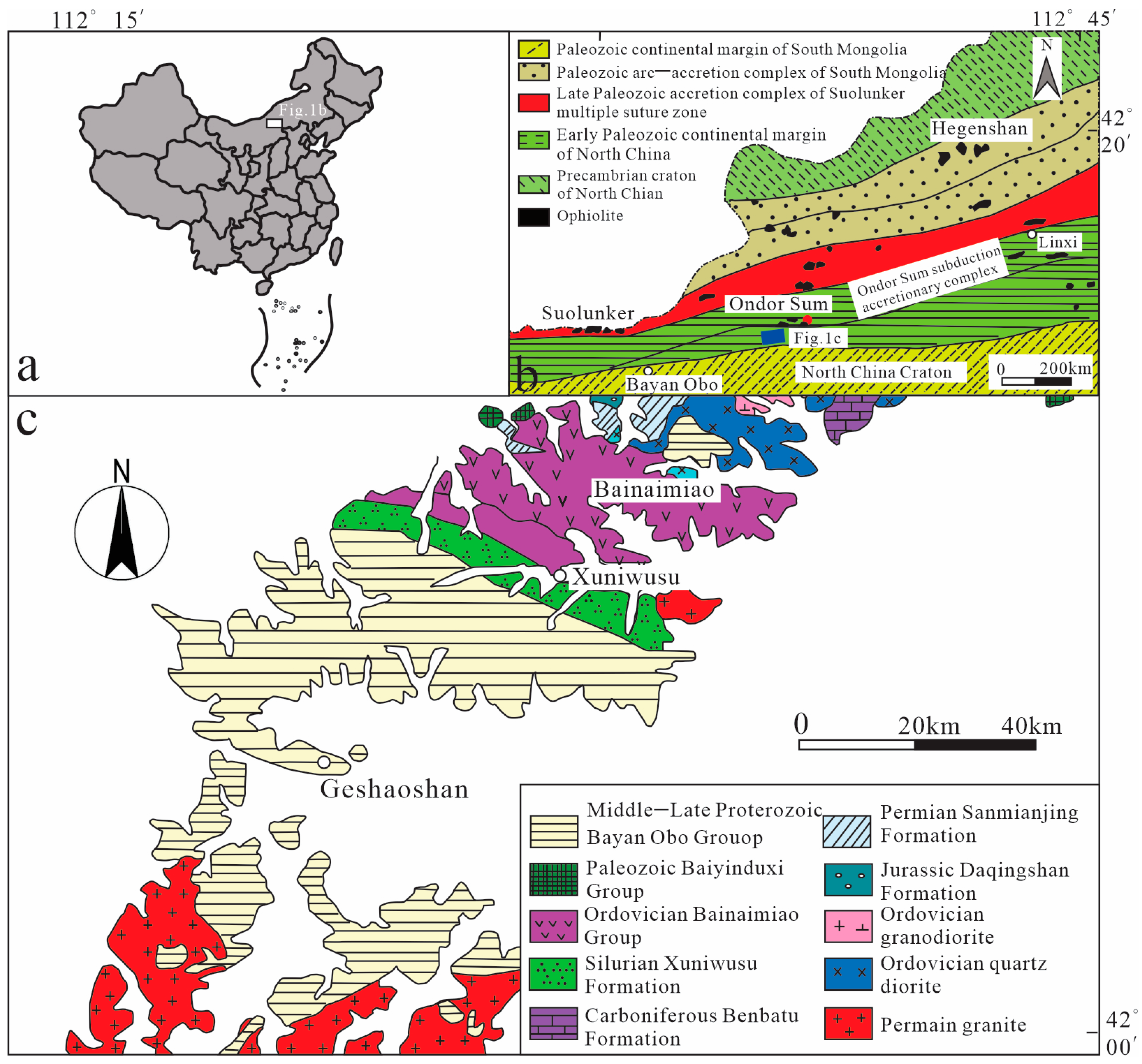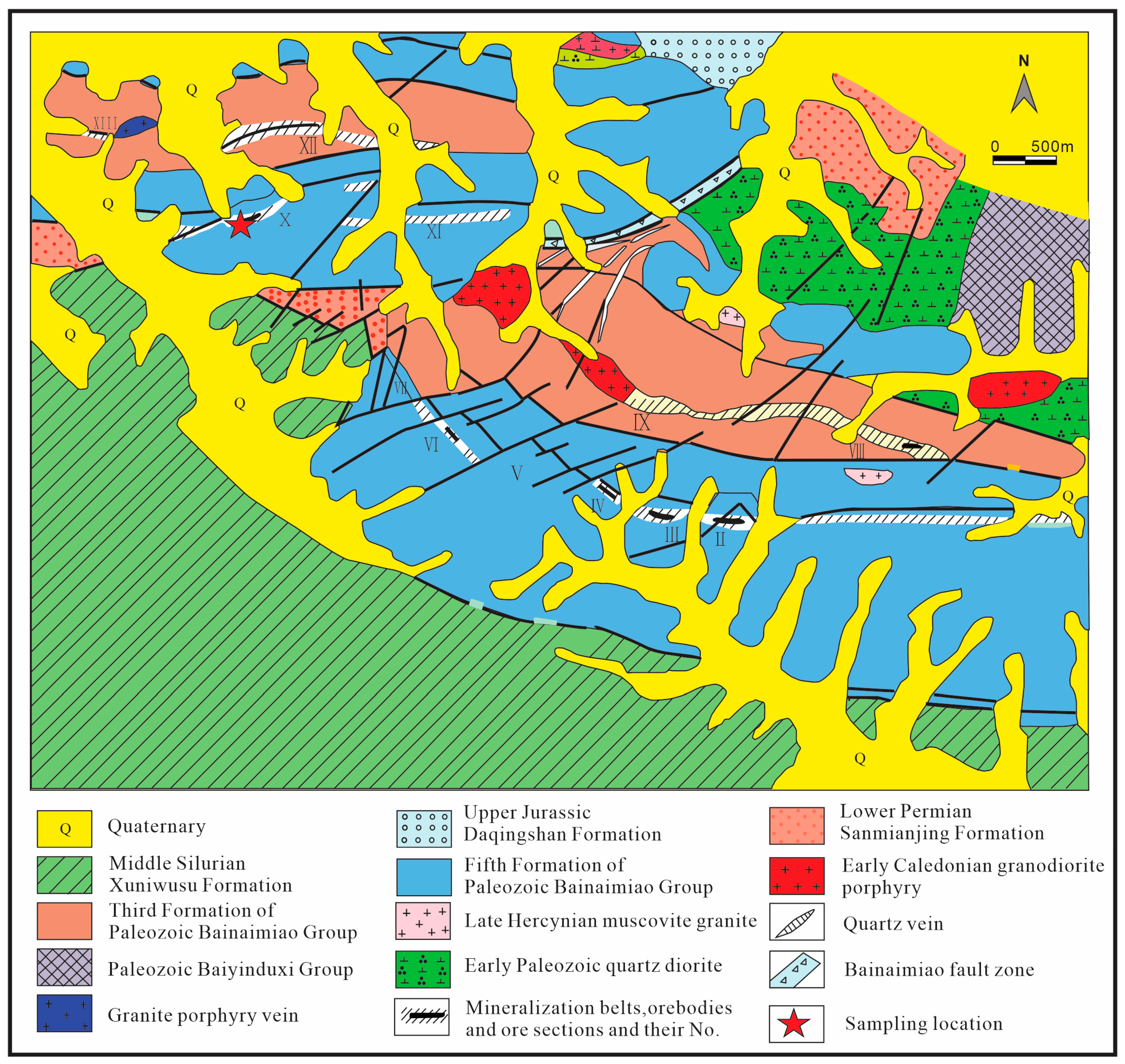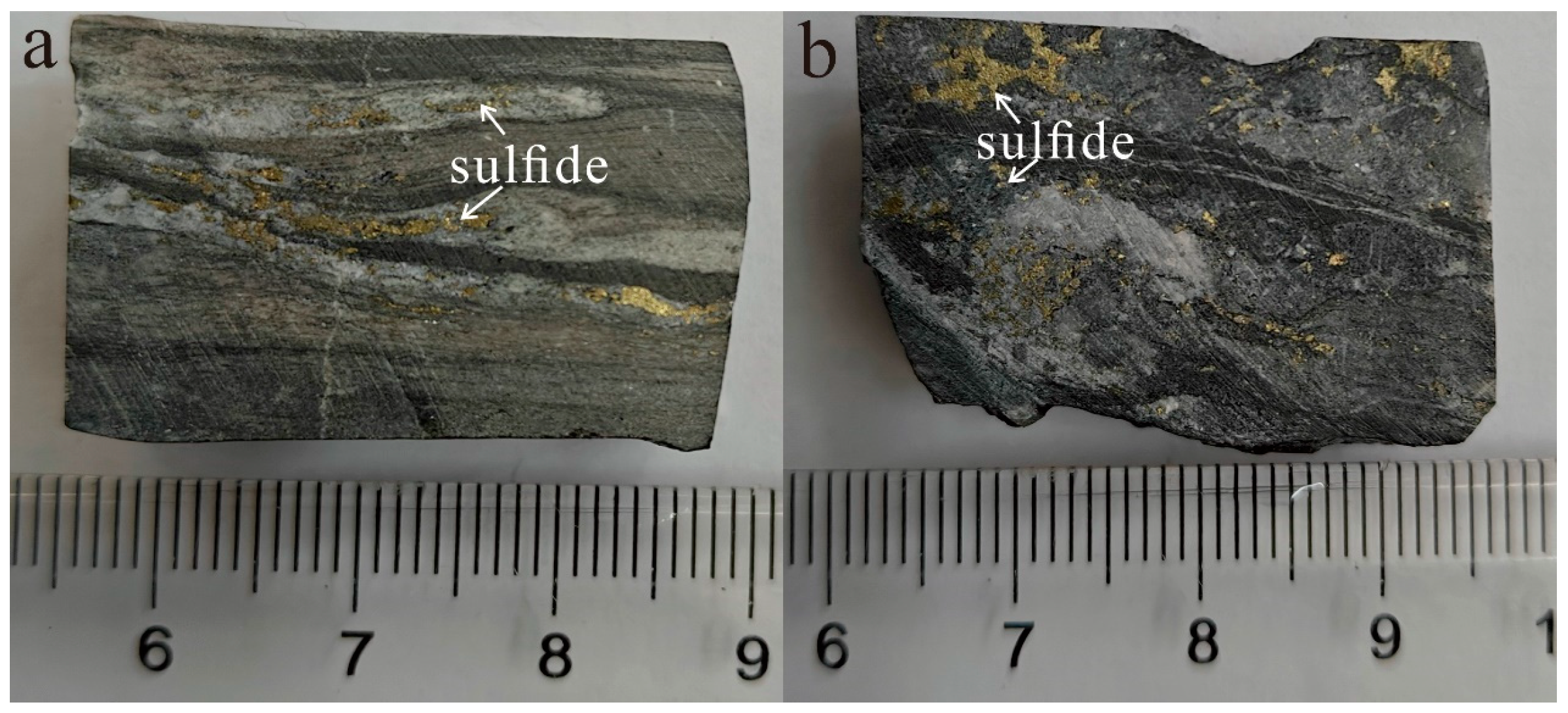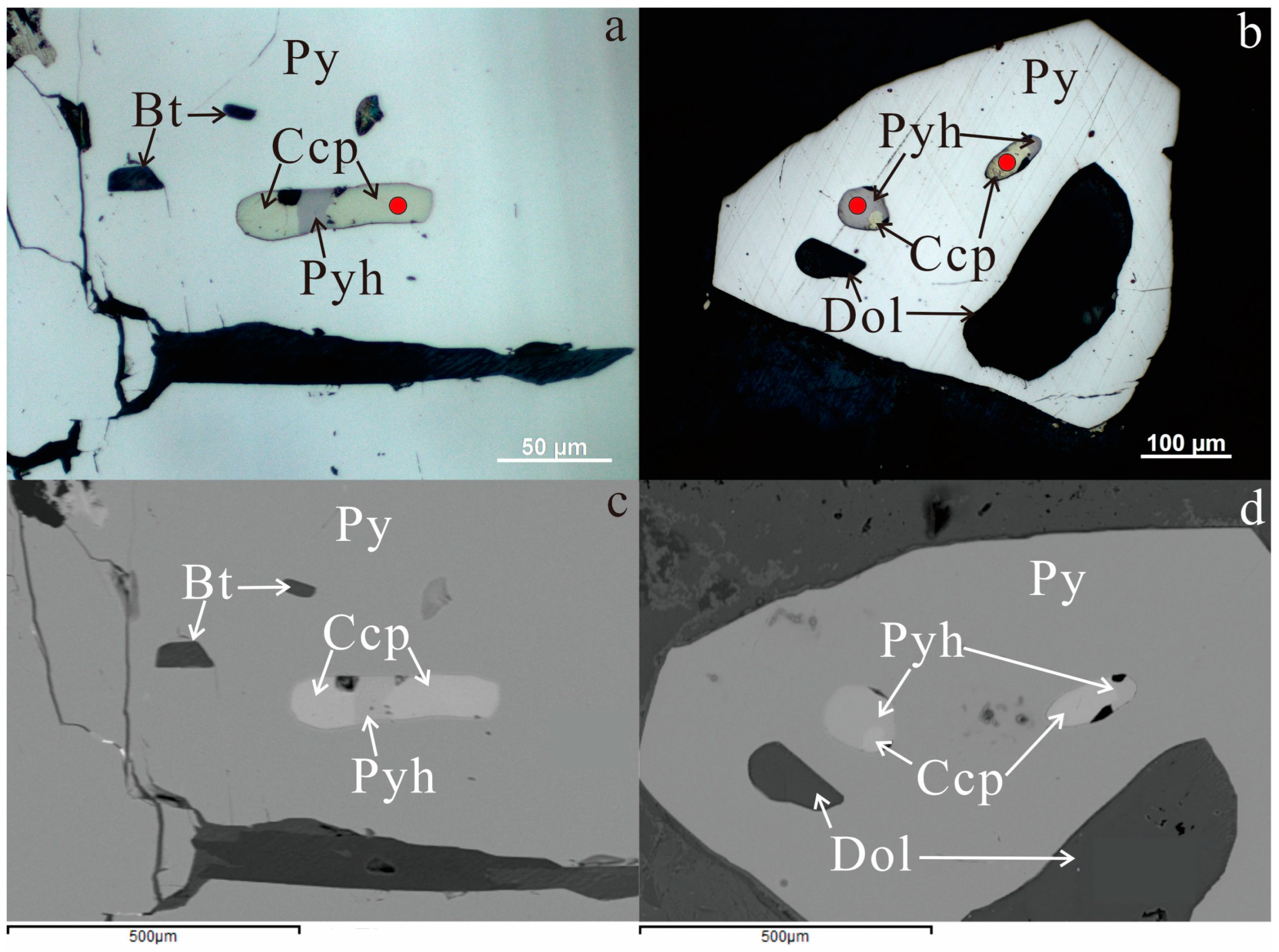Pyrite-Hosted Inclusions in the Southern Ore Belt of the Bainaimiao Porphyry Cu Deposit: Composition and δ34S Characteristics
Abstract
1. Introduction
2. Geological Settings
3. Ore Deposit Geology
4. Sample Descriptions and Analytical Methods
5. Results
5.1. The Characteristics of Pyrite-Hosted Inclusions
5.2. Sulfur Isotope Composition of Sulfide
6. Discussion
6.1. The Origin of Pyrite-Hosted Inclusions
6.2. Physicochemical Conditions of Early-Stage Mineralizing Fluids
6.3. The Genesis of the Bainaimiao Porphyry Cu Deposit
6.3.1. Key Distinctions from Alternative Genetic Models
6.3.2. Evidence for a Porphyry-Type Genesis of the Bainaimiao Cu Deposit
= 3(1 − X) FeS2 (pyrite) + 6X CuFeS2 (chalcopyrite) + (1 − X) Fe3O4.
7. Conclusions
Supplementary Materials
Author Contributions
Funding
Data Availability Statement
Acknowledgments
Conflicts of Interest
References
- Reich, M.; Deditius, A.; Chryssoulis, S.; Li, J.W.; Ma, C.Q.; Parada, M.A.; Barra, F.; Mittermayr, F. Pyrite as a record of hydro-thermal fluid evolution in a porphyry copper system: A SIMS/EMPA trace element study. Geochim. Cosmochim. Acta 2013, 104, 42–62. [Google Scholar] [CrossRef]
- Huston, D.L.; Sie, S.H.; Suter, G.F.; Cooke, D.R.; Both, R.A. Trace elements in sulfide minerals from eastern Australian volcanic-hosted massive sulfide deposits: Part I. Proton microprobe analyses of pyrite, chalcopyrite, and sphalerite, and part II. Selenium levels in pyrite: Comparison with δ34S values and impli. Econ. Geol. 1995, 90, 1167–1196. [Google Scholar] [CrossRef]
- Basori, M.B.I.; Gilbert, S.; Large, R.R.; Zaw, K. Textures and trace element composition of pyrite from the Bukit Botol volcanic-hosted massive sulphide deposit, Peninsular Malaysia. J. Asian Earth Sci. 2018, 158, 173–185. [Google Scholar] [CrossRef]
- Leach, D.L.; Taylor, R.D.; Fey, D.L.; Diehl, S.F.; Saltus, R.W. A deposit model for Mississippi Valley-type lead-zinc ores. In Chapter A of Mineral Deposit Models for Resource Assessment; USGS: Reston, VA, USA, 2010; Volume 107. [Google Scholar]
- Shikazono, N. Precipitation mechanisms of barite in sulfate-sulfide deposits in back-arc basins. Geochim. Cosmochim. 1994, 58, 2203–2213. [Google Scholar] [CrossRef]
- Lindaas, S.E.; Kulis, J.; Campbell, A.R. Near-infrared observation and microthermometry of pyrite-hosted fluid inclusions. Econ. Geol. 2002, 97, 603–618. [Google Scholar] [CrossRef]
- Large, R.R.; Maslennikov, V.V.; Robert, F.; Danyushevsky, L.V.; Chang, Z. Multistage sedimentary and metamorphic origin of pyrite and gold in the Giant Sukhoi log deposit, Lena Gold Province, Russia. Econ. Geol. 2007, 102, 1233–1267. [Google Scholar] [CrossRef]
- Large, R.R.; Danyushevsky, L.; Hollit, C.; Maslennikov, V.; Meffre, S.; Gilbert, S.; Bull, S.; Scott, R.; Emsbo, P.; Thomas, H.; et al. Gold and Trace Element Zonation in Pyrite Using a Laser Imaging Technique: Implications for the Timing of Gold in Orogenic and Carlin-style Sediment-Hosted Deposits. Econ. Geol. 2009, 104, 635–668. [Google Scholar] [CrossRef]
- Dmitrijeva, M.; Cook, N.J.; Ehrig, K.; Ciobanu, C.L.; Metcalfe, A.V.; Kamenetsky, M.; Kamenetsky, V.S.; Gilbert, S. Multivariate statistical analysis of trace elements in pyrite: Prediction, bias and artefacts in defining mineral signatures. Minerals 2020, 10, 61. [Google Scholar] [CrossRef]
- Deditius, A.P.; Utsunomiya, S.; Reich, M.; Kesler, S.E.; Ewing, R.C.; Hough, R.; Walshe, J. Trace metal nanoparticles in pyrite. Ore Geol. Rev. 2011, 42, 32–46. [Google Scholar] [CrossRef]
- Cook, N.J.; Ciobanu, C.L.; Mao, J. Textural control on gold distribution in As-free pyrite from the Dongping, Huangtuliang and Hougou gold deposits, North China Craton (Hebei Province, China). Chem. Geol. 2009, 264, 101–121. [Google Scholar] [CrossRef]
- Cook, N.J.; Ciobanu, C.L.; Meria, D.; Silcock, D.; Wade, B. Arsenopyrite-pyrite association in an orogenic gold ore: Tracing mineralization history from textures and trace elements. Econ. Geol. 2013, 108, 1273–1283. [Google Scholar] [CrossRef]
- Voute, F.; Hagemann, S.G.; Evans, N.J.; Villanes, C. Sulfur isotopes, trace element, and textural analyses of pyrite, arsenopyrite and base metal sulfides associated with gold mineralization in the Pataz-Parcoy district, Peru: Implication for paragenesis, fluid source, and gold deposition mechanisms. Miner. Depos. 2019, 54, 1077–1100. [Google Scholar] [CrossRef]
- Xiao, W.J.; Windley, B.F.; Hao, J.; Zhai, M. Accretion leading to collision and the Permian Solonker suture, Inner Mongilia, China: Termination of the Central Asian Orogenic Belt. Tectonics 2003, 22, 1069. [Google Scholar] [CrossRef]
- Liu, C.F.; Liu, W.C.; Wang, H.P.; Zhou, Z.G.; Zhang, H.F.; Tang, Y.J. Geochronology and geochemistry of the Bainaimiao metavolcanic rocks in the Northern margin of North China Craton. Acta Geol. Sin. 2014, 88, 1273–1287. [Google Scholar]
- Li, W.; Hu, C.; Zhong, R.; Xu, C.; Zhu, F. U–Pb, Ar39/Ar40 geochronology of the metamorphosed volcanic of the Bainaimiao Group in the central Inner Mongolia and its implications for ore genesis and geodynamic setting. J. Asian Earth Sci. 2012, 97, 251–259. [Google Scholar] [CrossRef]
- Li, J.W.; Zhao, S.B.; Huang, G.J.; Ma, R. Origin of Bainaimiao copper deposit, Inner Mongolia. Geol. Prospect. 2007, 43, 1–5. [Google Scholar]
- Shimazaki, H. Cooling history of orebody recorded in sphalerite: An example from the Tsumo skarn deposits, Japan. J. Fac. Sci. Univ. Tokyo Sect. II 1980, 20, 61–76. [Google Scholar]
- Govindarao, B.; Pruseth, K.L.; Mishra, B. Sulfide partial melting and chalcopyrite disease: An experimental study. Am. Mineral. 2018, 103, 1200–1207. [Google Scholar] [CrossRef]
- Bortnikov, N.S.; Genkin, A.D.; Dobrovol’Skaya, M.G.; Muravitskaya, G.N.; Filimonova, A.A. The nature of chalcopyrite inclusions in sphalerite; exsolution, coprecipitation, or “disease”? Econ. Geol. 1991, 86, 1070–1082. [Google Scholar] [CrossRef]
- Naglik, B.; Dumańska-Słowik, M.; Toboła, T.; Derkowski, P.; Habryn, R.; Markowiak, M. Diversity of Pyrite-Hosted Solid Inclusions and Their Metallogenic Implications—A Case Study from the Myszków Mo–Cu–W Porphyry Deposit (the Kraków–Lubliniec Fault Zone, Poland). Minerals 2021, 11, 1426. [Google Scholar] [CrossRef]
- Yund, R.A.; Kullerud, G. Thermal stability of assemblages in the Cu—Fe—S system. J. Petrol. 1966, 7, 454–488. [Google Scholar] [CrossRef]
- David, R.W.; Hans, P.E. Stability of biotite: Experiment, theory, and application. Am. Mineral. J. Earth Planet. Mater. 1965, 50, 1228–1272. [Google Scholar]
- Lusk, J.; Bray, D.M. Phase relations and the electrochemical determination of sulfur fugacity for selected reactions in the Cu–Fe–S and Fe–S systems at 1 bar and temperatures between 185 and 460 C. Chem. Geol. 2002, 192, 227–248. [Google Scholar] [CrossRef]
- Feng, X.X.; Yao, S.Z.; Duan, M.; Wang, J.Y.; Qu, K.; Wei, J.L.; Li, G.Y.; Zhu, Q. LA-ICP-MS zircon U-Pb dating of the gold-bearing quartz veins in the Bainaimiao Au deposit of Inner Mongolia and its geological significance. Geol. Bull. China 2014, 33, 1492–1501. [Google Scholar]
- Wang, J.P.; Liu, J.J.; Jiang, X.D.; Wang, B.; Jiang, S.M. Ar-Ar dating of biotite from the Haoyao’erhudong Au deposit, Inner Mongolia and its geological significance. Acta Mineral. Sin. 2011, S1, 643–644. [Google Scholar]
- Zhao, Y.; Wang, J.P.; Yang, Z.H.; Liao, D.J.; Lian, C.Y.; Liu, C.H.; Li, C.F.; Xue, Y.S.; Zuo, H.Y.; Yang, G. Stable Isotopic Geochemistry of the Bainaimiao Copper Deposit. Acta Geol. Sin. Engl. Ed. 2014, 88, 660–661. [Google Scholar] [CrossRef]
- Nie, F.J.; Pei, R.F.; Wu, L.S.; Zhang, H.T. Magmatic Activity and Metallogeny of the Bainaimiao District, Inner Mongolia, People’s Republic of China; Beijing Science and Technology Press: Beijing, China, 1993; pp. 121–145. [Google Scholar]
- Li, W.; Zhong, R.; Xu, C.; Song, B.; Qu, W. U–Pb and Re–Os geochronology of the Bainaimiao Cu–Mo–Au deposit, on the northern margin of the North China Craton, Central Asia Orogenic Belt: Implications for ore genesis and geodynamic setting. Ore Geol. Rev. 2012, 48, 139–150. [Google Scholar] [CrossRef]
- Mao, J.W.; Zhou, Z.H.; Wu, G.; Jiang, S.H.; Liu, C.L.; Li, H.M.; Ouyang, H.G.; Liu, J. Metallogenic regularity and minerogenetic series of ore deposits in Inner Mongolia and adjacent areas. Min. Depos. 2013, 32, 715–729. [Google Scholar]
- Li, W.B.; Chen, Y.J.; Lai, Y.; Ji, J.Q. Metallogenic time and tectonic setting of the Bainaimiao Cu-Au deposit, Inner Mongolia. Acta Petrol. Sin. 2008, 24, 890–898. [Google Scholar]
- Xin, H.B. Geological Characteristics and Genesis of the Bainaimiao Copper-Polymetallic Deposit, Inner Mongolia. Contrib. Geol. Miner. Resour. 2006, 4, 236–240+298. [Google Scholar]
- Zhou, Z.H.; Mao, J.W.; Ma, X.H.; Che, H.W.; Ou’yang, H.G.; Gao, X. Geochronological framework of the early Paleozoic Bainaimiao Cu-Mo-Au deposit, NE China, and its tectonic implications. J. Asian Earth Sci. 2017, 144, 323–338. [Google Scholar] [CrossRef]
- Zhao, Y. Geological and Geochemical Characteristics of the Bainaimiao Copper Deposit in Inner Mongolia and Its Geological Significance; China University of Geosciences Beijing: Beijing, China, 2013. [Google Scholar]
- Feng, X.X.; Yao, S.Z.; Duan, M.; Qu, K.; Wang, J.Y.; Feng, X.B.; Li, C.; Zhou, L.M. Re-Os dating of molybdenite from the Bainaimiao Cu (Mo) deposit in Inner Mongolia and its geological significance. J. Jilin Univ. Earth Sci. Ed. 2015, 45, 132–141. [Google Scholar]
- Chen, Y.J.; Ni, P.; Fan, H.R.; Pirajno, F.; Lai, Y.; Su, W.C.; Zhang, H. Diagnostic fluid inclusions of different types hydrothermal gold deposits. Acta Petrol. Sin. 2007, 9, 2085–2108. [Google Scholar]
- Rosenbaum, J.M.; Zindler, A.; Rubenstone, J.L. Mantle fluids: Evidence from fluid inclusions. Geochim. Cosmochim. Acta 1996, 60, 3229–3252. [Google Scholar] [CrossRef]
- Diamond, L.W. Review of the systematics of CO2–H2O fluid inclusions. Lithos 2001, 55, 69–99. [Google Scholar] [CrossRef]
- Wilkinson, J.J. Fluid inclusions in hydrothermal ore deposits. Lithos 2001, 55, 229–272. [Google Scholar] [CrossRef]
- Chen, Y.J. Orogenic-type deposits and their metallogenic model and exploration potential. Geol. China 2006, 33, 1181–1196. [Google Scholar]
- Harlov, D.E. Apparent pyrrhotite-chalcopyrite solid solutions in charnockites: The Shevaroy Hills Massif, Tamil Nadu, S India and the Bamble Sector, SE Norway. Mineral. Mag. 2000, 64, 853–865. [Google Scholar] [CrossRef]
- Han, J. Study on Geological Characteristics and Metallogenic Regularity of the Bainaimiao Copper Deposit, Siziwang Banner, Inner Mongolia Autonomous Region; 103 Geological Brigade Printing House: Ulanqab, China, 1987; pp. 1–105. [Google Scholar]
- Ji’an, S. Continental crust accretion and tectono-magmatic activity at the northern margin of the Sino-Korean plate. J. Southeast Asian Earth Sci. 1989, 3, 57–62. [Google Scholar] [CrossRef]
- Wu, J.H.; Li, H.; Xi, X.S.; Kong, H.; Wu, Q.H.; Peng, N.L.; Wu, X.M.; Cao, J.Y.; Gabo-Ratio, J.A.S. Geochemistry and geochronology of the mafic dikes in the Taipusi area, northern margin of North China Craton: Implications for Silurian tectonic evolution of the Central Asian Orogen. J. Earth Syst. Sci. 2017, 126, 64. [Google Scholar] [CrossRef]
- Zhou, Z.G.; Zhang, D.; Gu, Y.C.; Wang, G.S.; Li, H.Y.; Yu, Y.S.; Liu, C.F.; Liu, W.C. Characteristics of Bainaimiao thrust belt along Central Inner Mongolia in North China and its geological significance. Geotecton. Metallog. 2018, 42, 1–17. [Google Scholar]
- Ma, G.; Shen, P.; Pan, H.D.; Chao, C.; Feng, H.X.; Zhou, M.H. Zircon U-Pb geochronology, trace element composition and geochemistry of ore-bearing porphyry in Bainaimiao Cu-Au deposit, Inner Mongolia, and the implications for mineralization. Acta Geol. Sin. 2019, 93, 3144–3165. [Google Scholar]







| Mineral | δ34SVCDT (‰) | 2σ |
|---|---|---|
| Pyrite in Figure 5b | −5.63 | 0.13 |
| Pyrite in Figure 5d | −5.85 | 0.21 |
| Pyrite in Figure 5f | −5.66 | 0.14 |
| Chalcopyrite in Figure 5f | −5.44 | 0.29 |
| Chalcopyrite in Figure 6a | −5.40 | 0.31 |
| Chalcopyrite in Figure 6b | −5.16 | 0.32 |
| Pyrrhotite in Figure 6b | −4.97 | 0.17 |
Disclaimer/Publisher’s Note: The statements, opinions and data contained in all publications are solely those of the individual author(s) and contributor(s) and not of MDPI and/or the editor(s). MDPI and/or the editor(s) disclaim responsibility for any injury to people or property resulting from any ideas, methods, instructions or products referred to in the content. |
© 2025 by the authors. Licensee MDPI, Basel, Switzerland. This article is an open access article distributed under the terms and conditions of the Creative Commons Attribution (CC BY) license (https://creativecommons.org/licenses/by/4.0/).
Share and Cite
Wu, L.; Zuo, Y.; Zhang, Y.; Yang, J.; Liu, Y.; Zhang, G.; Zhang, H.; Zhang, P.; Liu, R. Pyrite-Hosted Inclusions in the Southern Ore Belt of the Bainaimiao Porphyry Cu Deposit: Composition and δ34S Characteristics. Minerals 2025, 15, 729. https://doi.org/10.3390/min15070729
Wu L, Zuo Y, Zhang Y, Yang J, Liu Y, Zhang G, Zhang H, Zhang P, Liu R. Pyrite-Hosted Inclusions in the Southern Ore Belt of the Bainaimiao Porphyry Cu Deposit: Composition and δ34S Characteristics. Minerals. 2025; 15(7):729. https://doi.org/10.3390/min15070729
Chicago/Turabian StyleWu, Liwen, Yushan Zuo, Yongwang Zhang, Jianjun Yang, Yimin Liu, Guobin Zhang, Hong Zhang, Peng Zhang, and Rui Liu. 2025. "Pyrite-Hosted Inclusions in the Southern Ore Belt of the Bainaimiao Porphyry Cu Deposit: Composition and δ34S Characteristics" Minerals 15, no. 7: 729. https://doi.org/10.3390/min15070729
APA StyleWu, L., Zuo, Y., Zhang, Y., Yang, J., Liu, Y., Zhang, G., Zhang, H., Zhang, P., & Liu, R. (2025). Pyrite-Hosted Inclusions in the Southern Ore Belt of the Bainaimiao Porphyry Cu Deposit: Composition and δ34S Characteristics. Minerals, 15(7), 729. https://doi.org/10.3390/min15070729






